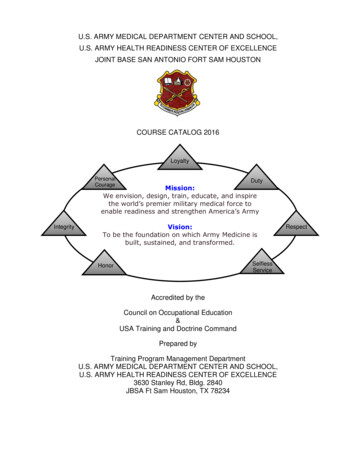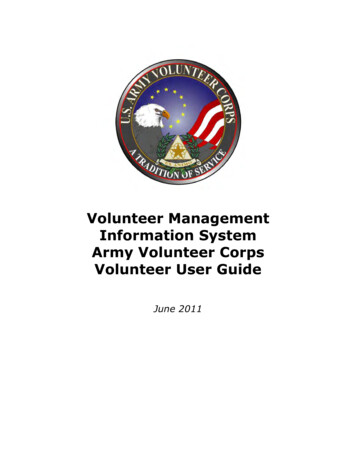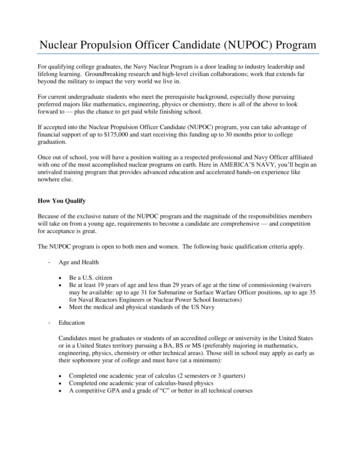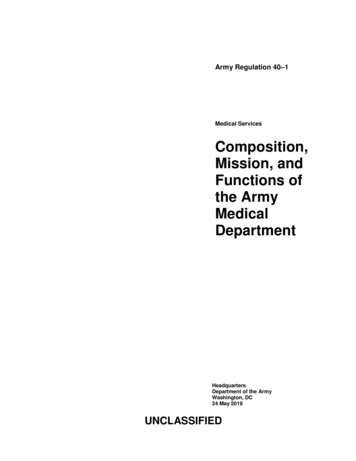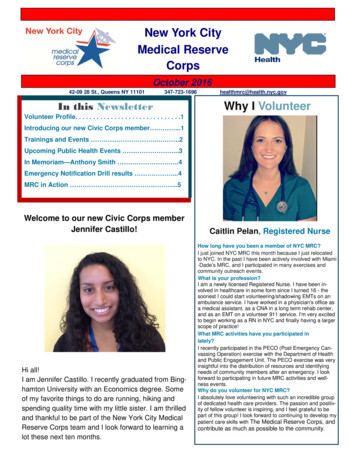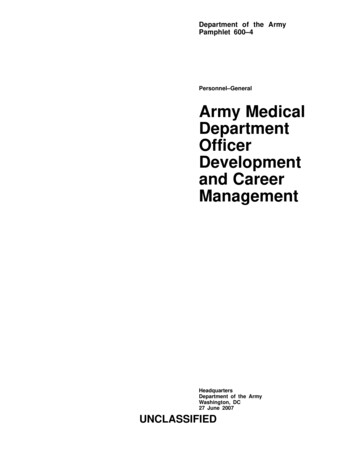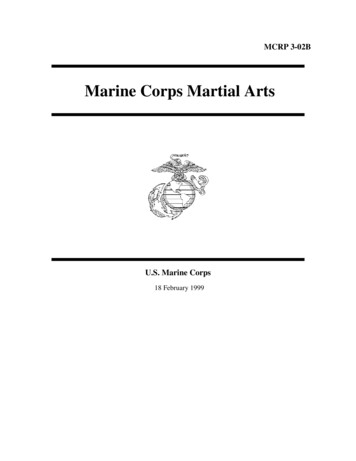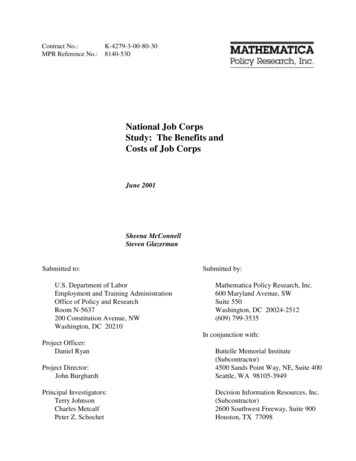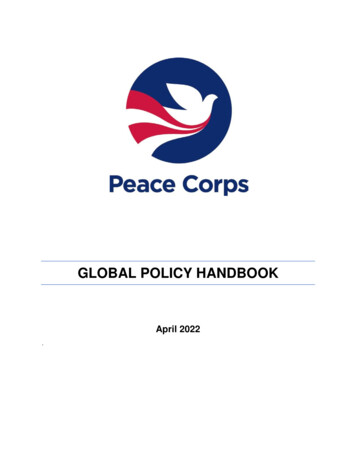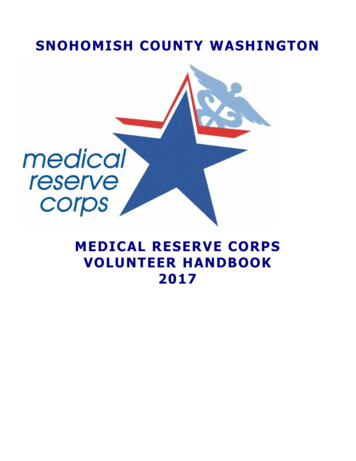
Transcription
S NOH OMIS H COUNT Y WASHINGTONMEDICA L RESER VE CORPSV OLUNTEER HAN DBOOK2017
Snohomish County Chapter, Medical Reserve CorpsTable of ContentsABOUT THIS HANDBOOK . 3HISTORY OF CITIZEN CORPS/MEDICAL RESERVE CORPS . 4SNOHOMISH COUNTY MEDICAL RESERVE CORPS. 5MISSION OF THE SNOHOMISH COUNTY MEDICAL RESERVE CORPS . 5BENEFITS TO THE COMMUNITY. 5AN ORGANIZED TEAM APPROACH . 5BACKGROUND . 6RESULTS AND BENEFITS EXPECTED . 7GENERAL INFORMATION . 8VOLUNTEER ASSIGNMENTS . 8ASSEMBLY SITES .8IDENTIFICATION . 9VOLUNTEER SAFETY . 9MAINTAINING READINESS . 10TRAINING. ERROR! BOOKMARK NOT DEFINED.INCIDENT COMMAND SYSTEM AND NATIONAL INCIDENT MANAGEMENT SYSTEM . 9FUNDING. 7OUR EMBLEM . 12UPDATES & COMMUNICATIONS .10LIABILITY . 13INSURANCE . 13POLICIES . 13HARASSMENT-FREE ENVIRONMENT POLICY . 13SAFETY . 14ELECTRONIC COMMUNICATIONS POLICY . 14DRUG FREE WORKPLACE . 14VIOLENCE-FREE WORK ENVIRONMENT POLICY . 15CODE OF CONDUCT . 16INTRODUCTION . 16CODE OF CONDUCT . 16PERFORMANCE. 16COMMITMENT TO DIVERSITY . 17VOLUNTEER RIGHTS & RESPONSIBILITIES . 17VOLUNTEER RIGHTS . 18VOLUNTEER RESPONSIBILITIES . 18RECEIPT OF HANDBOOK . 19VOLUNTEER HANDBOOKRevised: 9/11/2017Page 2
Snohomish County Chapter, Medical Reserve CorpsAbout This HandbookYour enrollment and orientation are important first steps to an exciting and complex organization,which offers a variety of opportunities to serve our community. The following pages describe thebenefits to our volunteers, plus policies and procedures that provide a framework for the services wedeliver.The information in this handbook is extensive but not complete. Each position has policies andprocedures specific to the function you will perform.You will learn much of the information regarding your responsibilities on the job. If you have anyquestions along the way, contact us at 425-339-5268 or tquinn@snohd.org.Please take the time to read this handbook carefully. Then, keep it as a reference source to usewhen you have questions or concerns.We wish you a rewarding experience as a Medical Reserve Corps volunteer.VOLUNTEER HANDBOOKRevised: 9/11/2017Page 3
Snohomish County Chapter, Medical Reserve CorpsHistory of Citizen Corps/Medical Reserve CorpsUniting Communities - Preparing the NationCitizen Corps is FEMA's grassroots strategy to bring together government and community leadersto involve citizens in all-hazards emergency preparedness and resilience.Citizen Corps asks you to embrace the personal responsibility to be prepared; to get training in firstaid and emergency skills; and to volunteer to support local emergency responders, disaster relief,and community safety.The Medical Reserve Corps is the component of the Citizen Corps that will bring together localhealth professionals and others with an interest in training to volunteer in their community. They willassist local, existing community emergency medical response systems as well as provide a group ofreadily trained and available resources to help our community deal with pressing public health needsand disasters.Volunteers are key to making our community a safer place to live. We look forward to working withyou in this important community effort.VOLUNTEER HANDBOOKRevised: 9/11/2017Page 4
Snohomish County Chapter, Medical Reserve CorpsSnohomish County Medical Reserve CorpsMission of the Snohomish County Medical Reserve CorpsThe mission of the Medical Reserve Corps (MRC) is to allow local volunteer medical, health, and nonmedical professionals to contribute their skills and expertise throughout the year as well as duringtimes of community need. Our Medical Reserve Corps unit is made of volunteers who can assist ourcommunity during emergencies, such as natural disasters, unintentional or intentional manmadedisasters.Values of the Snohomish County Medical Reserve CorpsInclusion, Resilience, RespectBenefits to the CommunityMajor local emergencies can overwhelm the capability of first responders, especially during the first12-72 hours. When people are prepared to take care of themselves, their families and others duringtimes of crisis it allow first-responders to focus their efforts on the most critical, life threateningsituations.An organized, well trained Medical Reserve Corps unit means that volunteers can effectively respondto an emergency, are familiar with their community’s response plan, know what materials areavailable for their use, know who their partners in the response are, and know where their skills canbe utilized to their best advantage and in a coordinated manner.An Organized Team ApproachDuring an emergency, Snohomish County communities will activate their Comprehensive EmergencyManagement Plans (CEMPs). These plans define how emergency personnel (fire, law enforcement,emergency medical services) will respond to and manage the emergency. Spontaneous volunteersmay hinder rescue efforts because they may not be familiar with local plans or procedures.By creating a Medical Reserve Corps unit that is linked to our county’s CEMP, the members of theMedical Reserve Corps can truly benefit the community by knowing what their role is during anemergency, how they fit into the emergency plan, and how best to respond so that they are apositive support structure for the first responders.VOLUNTEER HANDBOOKRevised: 9/11/2017Page 5
Snohomish County Chapter, Medical Reserve CorpsBackgroundSnohomish County has had a number of Presidential declareddisasters over the years, including the SR 530 Flooding andSlide near Oso. Earthquakes and severe winter storms cancause Snohomish County to quickly become geographicallyisolated from the Puget Sound metropolitan areas.Snohomish County recognizes the need for a communityresponse structure. Snohomish County EmergencyManagement and the Snohomish Health District have partneredto develop the Snohomish County Medical Reserve Corps by:to1.Recruiting volunteers (both healthcareprofessionals and support staff) from varioushealth disciplines to include, but not limited to:retired medical professionals, RNs, LPNs,paramedics, veterinarians, pharmacists and other health professionals2.Partnering with hospitals, Tribal clinics, EMS, and the public health community todevelop medical command and control procedures and pre-positioned sites for medicalvolunteers to establish and manage when requested through Emergency SupportFunction (ESF) 8 under local County Comprehensive Emergency Management Plans(CEMPs).3.Pre-registering all MRC volunteers as Washington State Emergency Workers (thisregistration will also assist with liability issues) which requires completion of the FEMA100 & 700 classes.4.Developing a training and exercise program for volunteers.VOLUNTEER HANDBOOKRevised: 9/11/2017Page 6
Snohomish County Chapter, Medical Reserve CorpsResults and Benefits ExpectedRecruitment for the Medical Reserve Corps (MRC) iscommunity based. The recruitment process is not limited tophysicians and nurses. It is inclusive of all volunteersinterested in providing care in a disaster. This includeslicensed medical professionals, those in administrativeroles and individuals interested in learning how to fill othersupport roles. Snohomish County MRC is designed to uselocal health care professionals within the community andaccommodates the volunteers’ schedules. The SnohomishCounty MRC is also recruiting individuals who may not bemedical professionals, but would like to help in times ofcrisis. That would include support staff for points ofdispensing, alternate care facilities, surge support for theHealth District and other locations that the MRC may beactivated to assist.The Snohomish County MRC is incorporated into theSnohomish Health District’s emergency response plan, thelocal county Comprehensive Emergency Management Plan(CEMP) through Emergency Support Function (ESF) 8(public health and medical) and the County Department of Emergency Management’s OperationsCenter Plans. All emergency and disaster related functions of the MRC will be initiated through ESF8, and provide new volunteer opportunities within the public health system. The MRC will enhanceand improve the emergency medical response capacity in the community. The program enhancesSnohomish County’s ability to respond to either a natural hazard or a manmade incident. With preplanning, pre-identification of treatment sites, and pre-identified, certified, and trained volunteers, asafe, rapid, and effective service will be available in a major emergency or disaster.FundingVolunteer time is uncompensated.VOLUNTEER HANDBOOKRevised: 9/11/2017Page 7
Snohomish County Chapter, Medical Reserve CorpsGeneral InformationVolunteer AssignmentsVolunteer applications will go through the Snohomish Health District. A volunteer must complete theFEMA 100 (the Incident Command System & 700 (the National Incident Management System)courses and supply prove of passing those tests to the MRC Coordinator. The application processincludes: Emergency worker form General application Skills assessment form Permissions form Background check formSnohomish County MRC may pre-assign volunteers in advance of emergencies and public healthactivities. MRC volunteers may be assigned to specific geographic locations to respond toemergencies, designed to be located near their home or place of employment.The Medical Reserve Corps unit will work closely with the local Health Officer, Emergency Managers,and emergency leaders because of their ongoing responsibilities and specific expertise.Some of the sites and positions that MRC will be called upon to work are:a.b.c.d.Manage Points of Dispensing in coordination with Medical Countermeasures (MCM).Provide surge support at hospitals, alternate care facilities and triage sites.Support shelter operations.Other duties as assigned.Assembly SitesIn the event of a catastrophic event, if the MRC staff and volunteers cannot communicate via phoneor email, volunteers can go to the closest assembly site to check in with staff to find out what theneeds are in the community. Volunteers are not deployed at this point, but the assembly sites are incontact with MRC staff via radio and volunteers can be assigned/deploy at that time, should they beneeded.The assembly sites are as follows: Cascade Valley Hospital – 330 Stillaguamish Ave. Arlington, WA 98223 (cafeteria) EvergreenHealth Monroe – 14701 179th Ave S.E. Monroe, WA 98272 (main entrance lobby) Providence Pacific Campus – 916 Pacific Avenue, Everett, WA 98201 (cafeteria) Providence Colby Campus – 1321 Colby Avenue, Everett, WA 98201 (cafeteria) Puget Sound Gastroenterology – 21600 Highway 99, Suite 260, EdmondsVOLUNTEER HANDBOOKRevised: 9/11/2017Page 8
Snohomish County Chapter, Medical Reserve CorpsIdentificationAll Snohomish County MRC volunteers will need to fill out anEmergency Worker Registration Card. Once that is complete, anEmergency Worker number will be assigned to that volunteer. An IDPhoto Badge will be issued with that EM Worker number. They willalso be issued MRC shirts (1 long sleeve and 1 short sleeve), to wearon assignments as well as a go-bag with safety supplies.Volunteer SafetyAll volunteers will receive safety training that is appropriate to theirfunction in the Medical Reserve Corps unit. It is stronglyrecommended and encouraged that all volunteers will be vaccinatedagainst seasonal influenza (every year); chickenpox; measles, mumps& rubella; tetanus, diphtheria, pertussis. Health care professionalsshould also be vaccinated against Hepatitis B and have PPDs.Volunteers are encouraged to send in physician/clinic records that show immunity to chickenpox,measles, mumps, rubella and Hepatitis B. Similar documentation of a TDaP vaccine and seasonalinfluenza vaccination is also recommended. Documentation of immunity can be obtained from yourhealth care provider through a blood draw (a titer).While it is not required for volunteers to be immune to these diseases, those volunteers who do nothave documented immunity, will not be called to respond in an outbreak of any of these diseases.For instance, if we have an outbreak of measles, volunteers who do not have a documentedimmunity to measles will not be activated for the response.All volunteers must complete the volunteer packet and at a minimum must complete the emergencyworker form, the FEMA 100 & 700 courses and the background check. Volunteers who are under theage of 18 may volunteer if they have completed the parental consent form and are at least 16 yearsof age.Classes in Basic Life Support (BLS) will be offered for free to nurses and EMTS and first aid/CPR willbe offered for free to other MRC volunteers. Online training in bloodborne pathogens is requiredannually. Training in HIPAA is also available online. MRC Orientations are scheduled throughout theyear. Just in time trainings are offered as needed.Other trainings are made available during the evening and on weekends. Those trainings and otherinformation can be found at the Snohomish County MRC website. The National web site is athttps://mrc.hhs.gov/HomePageVOLUNTEER HANDBOOKRevised: 9/11/2017Page 9
Snohomish County Chapter, Medical Reserve CorpsMaintaining ReadinessRegular training exercises are an essential element for ensuring readiness.Being ready to respond in an emergency does not just happen—readiness requires planning,organization and practice. Snohomish County Medical Reserve Corps has regular trainings and drillsto ensure maximum emergency preparedness.All Medical Reserve Corps volunteers must have appropriate education, training and experience. Notall members of the MRC unit need the same education and training, although there are somecommon elements.Preparedness is each individual’s responsibility. Ensuring you are prepared at home and at work willallow you to be ready to respond when you are needed. Your local Department of EmergencyManagement has free information that can help you prepare for all hazards. You may also check theDepartment of Emergency Management website at nt and the Snohomish Health District website at http://www.snohd.org/ for additionalemergency preparedness information.VOLUNTEER HANDBOOKRevised: 9/11/2017Page 10
Snohomish County Chapter, Medical Reserve CorpsCORE COMPETENCIES FOR MRC VOLUNTEERSThe MRC Core Competencies have been aligned with the Disaster Medical and Public Health Core(DMPH) competencies. They are listed below:1. Demonstrate personal and family preparedness for disasters and public health emergencies.2. Demonstrate knowledge of one’s expected role(s) in organizational and community responseplans activated during a disaster or public health emergency.3. Demonstrate situational awareness of actual/potential health hazards before, during, and aftera disaster or public health emergency.4. Communicate effectively with other in a disaster or public health emergency.5. Demonstrate knowledge of personal safety measures that can be implemented in a disaster orpublic health emergency.6. Demonstrate knowledge of surge capacity assets consistent with one’s role in organizational,agency, and/or community response plans.7. Demonstrate knowledge of principles and practices for the clinical management of all ages andpopulations affected by disasters and public health emergencies, in accordance withprofessional scope of practice.8. Demonstrate knowledge of public health principles and practices for the management of allages and populations affected by disasters and public health emergencies.9. Demonstrate knowledge of ethical principles to protect the health and safety of all ages,populations and communities affected by a disaster or public health emergency.10. Demonstrate knowledge of legal principles to protect the health and safety of all ages,populations, and communities affected by a disaster or public health emergency.11. Demonstrate knowledge of short- and long-term considerations for recovery of all ages,populations and communities affected by a disaster or public health emergency.These competencies have been developed into MRC Performance Qualifications as follows: Complete a personal and family preparedness plan – meets DMPH Competency 1 Demonstrate safe behaviors during MRC activities – meets DMPH Competency 5, 10 Follow procedures to successfully activate, report and demobilize – meets DMPH Competency 2Follow policies and procedures related to professional and ethical representation of the MRC –meets DMPH 2, 9, 10Describe the chain of command (e.g. NIMS, ICS) during MRC activities – meets DMPH 2Describe the members communication responsibilities and procedures – meets DMPH 4Describe how MRC serves the community – meets DMPH 3, 6, 7 & 8Identify the impact of an event on the behavioral health of the MRC member and their family,team and community – meets DMPH 7, 11Demonstrate cultural humility during MRC activities – meets DMPH 7, 8, 9, 10, 11Identify the role of public health in the community – meets DMPH 8VOLUNTEER HANDBOOKRevised: 9/11/2017Page 11
Snohomish County Chapter, Medical Reserve CorpsOur EmblemThe Medical Reserve Corps will be a recognized emblem that must be used ina standard form. There are guidelines that include color, placement, font andsize. Shirts and other gear may be issued to all credentialed MRC volunteersin Snohomish County, in order to be easily identified in the field.Updates & CommunicationAll Volunteers receive a weekly email update that includes information about training and exercise aswell as opportunities they may be interested in. Volunteers are encouraged to communicate with thecoordinator whenever necessary.Volunteers are registered into the mystateusa program, which allows the local MRC office andEmergency Management to quickly contact all volunteers within minutes during a disaster, whenevery minute counts.Our website is updated as often as possible and includes information about trainings.VOLUNTEER HANDBOOKRevised: 9/11/2017Page 12
Snohomish County Chapter, Medical Reserve CorpsLiabilityInsuranceThe State of Washington provides liability protection to volunteers who are registered as emergencyworkers and are working (and deployed) under a mission number. This protection gives similarprotection as workmen’s compensation does and also provides protection against loss or damage topersonal property during an activation. It also provides liability protection for volunteers who areworking within the scope of their training and not being grossly negligent or operating with willfuland wanton misconduct.WAC 118-04, http://apps.leg.wa.gov/WAC/default.aspx?cite 118-04 & RCW 38.52,http://apps.leg.wa.gov/RCW/default.aspx?cite 38.52&full true#38.52.005#38.52.005, provide theseprotections. Please go on-line to view these bills or contact the MRC office so a printout of the lawcan be sent to you.PoliciesHarassment-Free Environment PolicyThe Snohomish County Medical Reserve Corps (MRC) is committed toproviding a harassment and discrimination free work environment inwhich all individuals are treated with respect and dignity. Eachindividual has the right to work in a professional atmosphere thatpromotes equal opportunities and prohibits discriminatory practices,including harassment. It is the policy of the MRC that harassmentbased on race, color, religion, age, gender, sexual orientation, nationalorigin, marital status, disability, veteran status or any other basis isstrictly prohibited.Any harassment, whether verbal or physical, is unacceptable and willnot be tolerated. It is the intent that all MRC volunteers will work in anenvironment free from discrimination and/or harassment by anotheremployee, supervisor or another volunteer for any reason.Discriminatory conduct in any form undermines morale and interferes with productivity.The Snohomish County Medical Reserve Corps is committed to eradicating all discrimination in theworkplace and specifically condemns sexual harassment of county employees and volunteers by othercounty employees or volunteers.If you feel you may have been the subject of discrimination or harassment, you should contact theMRC Coordinator. Any reports of discrimination or harassment will be examined impartially andresolved promptly.VOLUNTEER HANDBOOKRevised: 9/11/2017Page 13
Snohomish County Chapter, Medical Reserve CorpsSafetyProviding a clean, safe and healthful work environment is a goal of the Snohomish County MedicalReserve Corps. No job is considered so important or urgent that volunteers cannot take time toperform their job safely.During your job site orientation, your supervisor will discuss all the applicable safety and health ruleswith you. If you are unclear about any safety policies and procedures, ask your supervisor orvolunteer manager.As an MRC volunteer, you have a responsibility for your own safety and health. This includes usingall required safety devices. You must also notify your supervisor of any physical conditions such asdrowsiness due to medication, illness or emotional strain, which may affect your performance andsafety.You are expected to immediately report all work-related accidents, injuries, illnesses and near missesto your supervisor or volunteer manager.Electronic Communications PolicySnohomish County’s electronic communication systems, including telephones, e-mail, voice mail,faxes and Internet, are available to conduct county business in a timely manner. All communicationsare to be professional and appropriate and users are prohibited from using electronic communicationsfor the solicitations of funds, political messages, harassing messages or personal use. Furthermore,all electronic data are the property of the local jurisdiction and may be considered public records.Drug Free WorkplaceThe Snohomish County Medical Reserve Corps (MRC) is dedicated to a safe, healthy and drug-freework environment. All MRC volunteers are expected to report to work free from drug and/or alcoholimpairment and to remain at work in a condition that enables them to perform their job duties in asafe, efficient, legal and professional manner. Snohomish County encourages volunteers who mayhave an alcohol and/or drug problem to voluntarily seek evaluation and treatment that will lead tosuccessful rehabilitation. Volunteers must abide by the provisions of this policy as a condition ofvolunteer service.VOLUNTEER HANDBOOKRevised: 9/11/2017Page 14
Snohomish County Chapter, Medical Reserve CorpsViolence-Free Work Environment PolicyThe Snohomish County Medical Reserve Corps (MRC) is committed to our volunteer’s safety andhealth. This policy has been developed to help ensure a safe workplace and to reduce the risk ofviolence.The MRC does not tolerate any type of acts or threats of violence committed by or against avolunteer, and therefore prohibit workplace violence and the possession of weapons by volunteers onthe job and at the worksite.In order to ensure a safe working environment, the Snohomish County Medical Reserve Corpsprohibits all persons from carrying a handgun, firearm, or weapon of any kind on assignments,regardless of whether the person is licensed to carry the weapon or not. This policy applies to allvolunteers, clients, customers and visitors. All volunteers are also prohibited from carrying or using aweapon while in the course and scope of performing their job, whether they are on our property atthe time or not. This policy also prohibits weapons at any Medical Reserve Corps sponsoredfunction, such as training missions, parties or any other events.The only exceptions to this policy are police officers, private security guards, or military personnelemployed by federal or state government, who are engaged in official duties and persons who havebeen given written consent by their supervisor or the director to carry a weapon while performingspecific tasks on behalf of the MRC.If you feel threatened, you should retreat and request intervention from a supervisor or otheravailable management staff. If fear of violence is imminent, immediately retreat and contact 911.VOLUNTEER HANDBOOKRevised: 9/11/2017Page 15
Snohomish County Chapter, Medical Reserve CorpsIntroductionCode of ConductIn an effort to maintain the high standard of conduct expected and deserved by the American publicand to enable the organization to continue to offer services required by those in need, the MRCoperates under the following Code of Conduct, applicable to all volunteers.Code of ConductNo volunteer shall:Authorize the use of or use for the benefit or advantage of any person, the name, emblem,endorsement, services, or property of the Medical Reserve Corps.Accept or seek on behalf of themselves or any other person, any financial advantage or gain of otherthan nominal value that may be offered because of the volunteer’s affiliation with the Medical ReserveCorps.Publicly utilize any Medical Reserve Corps affiliation in connection with the promotion of partisanpolitics, religious matters, or political positions on any issues.Disclose any confidential Medical Reserve Corps (MRC) information that is available solely as aresult of the volunteer’s affiliation with the MRC Corps to any person not authorized to receive suchinformation, or use to the disadvantage of the Medical Reserve Corps any such confidentialinformation, without the express authorization of the MRC.Knowingly take any action or make any statement intended to influence the conduct of the MedicalReserve Corps in such a way as to confer any financial benefit on any person, corporation, or entity
VOLUNTEER HANDBOOK Page 8 Revised: 9/11/2017 General Information Volunteer Assignments Volunteer applications will go through the Snohomish Health District. A volunteer must complete the FEMA 100 (the Incident Command System & 700 (the National Incident Management System) courses and supply prove of passing those tests to the MRC Coordinator.
